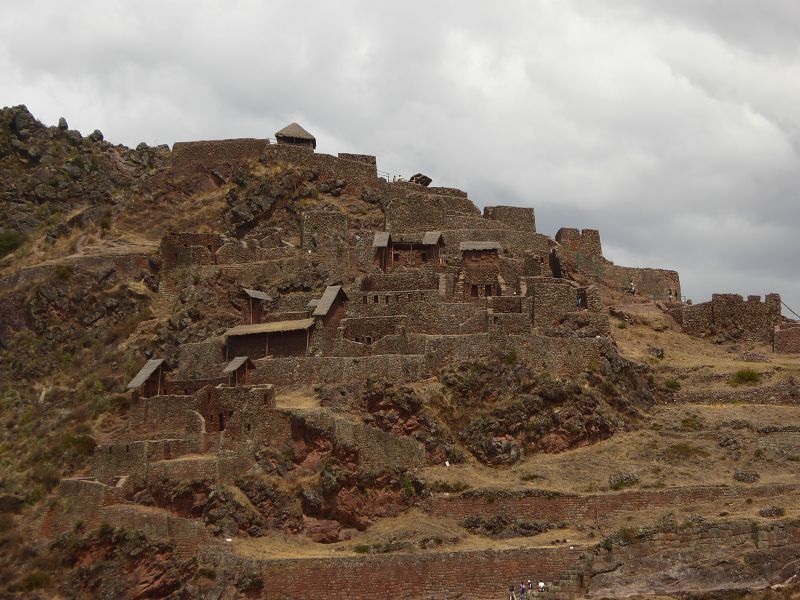|
Pisac is a charming town located in the
Sacred Valley of the
Inca Empire, in
Cusco Region, southern
Peru. It is famous for
its archaeological site,
which features impressive Inca
ruins, stunning
terraces, and breathtaking views of the surrounding valley.
Pisac is also a popular destination for both history enthusiasts and
nature lovers due to its rich cultural heritage and scenic landscapes.
Key Highlights of Pisac:
-
Pisac Archaeological Site:
-
Pisac is best
known for its Inca
archaeological site, which is located on the mountain
above the town. The site consists of
temples,
terraces, and
fortresses
built by the Incas around the
15th century.
- The site is divided into
several areas, including:
-
Intihuatana
(the sun dial):
This is one of the most important parts of the site. It is a
ritual stone
that was used by the Incas to track the sun's position,
marking important solar events.
-
Agricultural
Terraces: Pisac is famous for its extensive system
of agricultural
terraces built into the mountainside. These
terraces were used by the Incas for farming and are still in
use by locals today.
-
Temple of the Sun:
Another important structure at the site is the
Temple of the Sun,
which is aligned with the movement of the sun during the
solstices.
-
Fortifications:
The ruins on the mountain also include defensive structures
such as walls,
gates,
and watchtowers, offering amazing views of the valley below.
-
Pisac Market:
- The town of
Pisac is also
known for its vibrant
handicraft market, which is a great place to purchase
traditional Peruvian
textiles,
artwork,
jewelry,
pottery, and
other crafts.
- The market is especially
busy on Sundays when it is at its largest, attracting both
locals and tourists. It is also a great place to experience the
lively atmosphere of
local culture, taste fresh produce, and enjoy delicious
street food.
- The market is set against
a beautiful backdrop of the mountains, making shopping in Pisac
a unique and picturesque experience.
-
Pisac and the Sacred
Valley:
- Pisac is located in the
Sacred Valley of the
Incas, which is known for its
natural beauty
and historical
significance. The valley was a crucial area for the
Inca civilization,
offering fertile land, natural resources, and a strategic
location for agriculture, trade, and defense.
- The
Sacred Valley
is home to other key archaeological sites, such as
Ollantaytambo,
Moray, and
Chinchero,
making Pisac an ideal base for exploring the valley.
-
Hiking and Nature:
- In addition to the
archaeological site,
Pisac is also a popular location for
hiking and
nature walks.
The surrounding mountains and
Sacred Valley
provide numerous trekking opportunities, with trails leading
through forests,
terraces, and
villages.
- One popular hike is the
Pisac Mountain trek,
which leads to the top of the mountain where the ruins are
located. This trail offers incredible views of the
Sacred Valley
and is a rewarding experience for those interested in nature and
history.
-
Inca Influence:
- Pisac was an important
site during the Inca
Empire and played a significant role in their
agricultural and ceremonial practices. The
Inca religion
and astronomy
were deeply tied to the structures found at the site, such as
the Intihuatana
(sun dial) and various temples that honor the
sun,
moon, and
other deities.
- The site's strategic
location also made it an important
military and
defensive
stronghold.
-
Nearby Attractions:
-
Sacred Valley:
The entire valley is a UNESCO
World Heritage Site
and is filled with beautiful landscapes, Inca ruins, traditional
villages, and charming towns. Other nearby places to explore
include Moray
(a circular agricultural terrace),
Maras (salt
pans), and
Ollantaytambo (an ancient Inca fortress town).
-
Cusco: The
city of Cusco,
the former capital of the Inca Empire, is just a short drive
away from Pisac and is home to many
historic and
cultural
landmarks, including the
Sacsayhuamán ruins,
the Qorikancha temple,
and the Plaza de Armas.
Best Time to Visit Pisac:
- The best time to visit Pisac
is during the dry season,
which runs from May to
October. The weather is typically sunny and clear,
providing perfect conditions for hiking, exploring the ruins, and
enjoying the views.
- The
rainy season
(November to April) can bring heavier rainfall, especially in the
afternoons, but it can also bring lush greenery to the region and
fewer tourists.
How to Get to Pisac:
-
From Cusco: Pisac
is located about 32
kilometers (20 miles) from
Cusco and is
easily accessible by car or bus. The drive typically takes about
45 minutes to 1 hour.
-
Public Transport:
There are buses
and minivans that
run regularly between
Cusco and Pisac,
departing from the Calle
Pavitos area in Cusco.
-
Private Tours:
Many travelers opt for
private tours or guided trips, which can include
transportation, a guide, and visits to multiple sites in the Sacred
Valley.
In Summary:
Pisac is a beautiful
and historically significant town that offers a combination of
Inca ruins,
traditional culture, and stunning natural beauty. Whether you’re
interested in hiking, shopping for handicrafts, or exploring the
fascinating archaeological
site, Pisac is a great place to experience the culture and
history of the Sacred Valley.
It’s a must-visit for anyone traveling to the
Cusco region and a
perfect complement to the other historical and cultural sites in the
area.
|
|
 Safaris
Bergsteigen
Wandern
Inselwandern Weltweit
Safaris
Bergsteigen
Wandern
Inselwandern Weltweit
 Europa
Inselwandern
Europa
Inselwandern
 Städtewandern
Städtewandern
 Paintings
Paintings Dirk Rauschenbach
Dirk Rauschenbach
 Safaris
Bergsteigen
Wandern
Inselwandern Weltweit
Safaris
Bergsteigen
Wandern
Inselwandern Weltweit
 Europa
Inselwandern
Europa
Inselwandern
 Städtewandern
Städtewandern
 Paintings
Paintings Dirk Rauschenbach
Dirk Rauschenbach

![]() 26.07.25 Copyright Dirk
Rauschenbach Koelnerstrasse 293 51702 Bergneustadt
Datenschutzerklaerung 02261 9788972 Mail ccooly(
at) web.de
26.07.25 Copyright Dirk
Rauschenbach Koelnerstrasse 293 51702 Bergneustadt
Datenschutzerklaerung 02261 9788972 Mail ccooly(
at) web.de